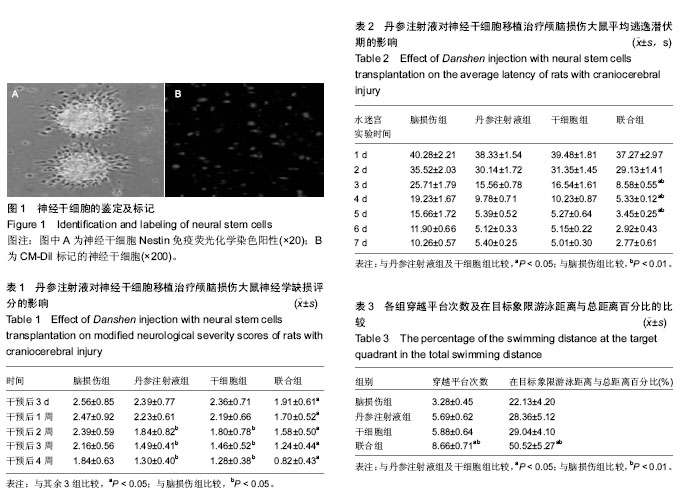| [1] Diaz-Arrastia R,Kenney K.Epidemiology of traumatic brain injury.Handb Clin Neurol.2015;127:3-13.[2] Haring RS,Narang K,Canner JK,et al.Traumatic brain injury in the elderly:morbidity and mortality trends and risk factors.J Surg Res.2015;195(1):1-9.[3] Fernandezrodriguez E,Bernabeu I,Castro AI,et al. Hypopituitarism after traumatic brain injury.Endocrinol Metab Clin North Am.2015;44(1):151-159.[4] 黄卫,岑丹辉,黄远德.颅脑损伤治疗进展[J].基层医学论坛,2014, 18(1):107-109.[5] Yoshida Y,Yamanaka S.Recent stem cell advances: induced pluripotent stem cells for disease modeling and stem cell–based regeneration. Circulation. 2010;122(1): 80-87.[6] 刘伟.神经干细胞研究进展及前景[J].科技信息,2011,28(16): 10172-10172.[7] Gage FH,Temple S.Neural stem cells:generating and regenerating the brain.Neuron.2013;80(3):588-601.[8] 贾璐,闫春华,吴丽娥.神经干细胞研究进展[J].医学综述, 2010,16(8):1149-1151.[9] Kim SU.Neural stem cell-based gene therapy for brain tumors.Stem Cell Rev Rep.2011;7(1):130-140.[10] 方庆,陈新生.神经干细胞相关研究进展[J].中国医药指南, 2011,9(8):44-46.[11] Xie C,Cong D,Wang X,et al.The effect of simvastatin treatment on proliferation and differentiation of neural stem cells after traumatic brain injury.Brain Res.2014;1602:1-8.[12] Ahmed A,Shtaya A,Zaben M,et al.Activation of endogenous neural stem cells after traumatic brain injury.Lancet.2014;383(383):S18.[13] Goodus MT,Guzman AM,Calderon F,et al.Neural stem cells in the immature,but not the mature,subventricular zone respond robustly to traumatic brain injury.Dev Neurosci.2015;37(1): 29-42.[14] Liu S,Li Z,Fu J,et al.The effects of harvesting media on biological characteristics and repair potential of neural stem cells after traumatic brain injury.Plos One.2014;9(9): e107865-e107865.[15] Ye YQ,Xu HY,Zhang X,et al.Association between Toll-Like Receptor 4 Expression and Neural Stem Cell Proliferation in the Hippocampus Following Traumatic Brain Injury in Mice.Int J Mol Sci.2014;15(7):12651-12664.[16] Jiang S,Chen W,Zhang Y,et al.Acupuncture Induces the Proliferation and Differentiation of Endogenous Neural Stem Cells in Rats with Traumatic Brain Injury.Evid Based Complement Alternat Med.2016;2016(4):1-8.[17] Thomaidou D.Neural Stem Cell Transplantation in an Animal Model of Traumatic Brain Injury.Methods Mol Biol. 2014; 1210: 9-21.[18] Haus DL,López-Velázquez L,Gold EM,et al.Transplantation of human neural stem cells restores cognition in an immunodeficient rodent model of traumatic brain injury.Exp Neurol.2016;281:1-16.[19] Aligholi H,Rezayat SM,Azari H,et al.Preparing neural stem/progenitor cells in PuraMatrix hydrogel for transplantation after brain injury in rats:A comparative methodological study.Brain Res.2016;1642:197-208.[20] Addington CP,Heffernan JM,Millarhaskell CS,et al.Enhancing neural stem cell response to SDF-1α gradients through hyaluronic acid-laminin hydrogels. Biomaterials.2015; 72: 11-19.[21] 樊欣鑫,李宇龙,万兴,等.神经干细胞移植治疗颅脑损伤后神经功能缺失的研究进展[J].现代医学,2013,41(4):274-278.[22] 刘兴华.神经干细胞移植在颅脑损伤后神经功能缺失中的应用研究进展[J].中国处方药,2015,13(10):20-21.[23] 赵宁,杨万章,李娇,等.丹参注射液对脑梗死患者自体外周血干细胞旁分泌BDNF的影响[J].中西医结合心脑血管病杂志,2013 11(1):49-51.[24] 赵宁,陆琳,杨万章,等.丹参注射液对急性脑梗死大鼠脑组织VEGF表达的影响[J].中西医结合心脑血管病杂志,2013,11(5): 584-586.[25] 林惠,杨万章.丹参注射液对脑梗死大鼠SVZ干细胞增殖作用的研究[J].中西医结合心脑血管病杂志,2014,12(3):350-352.[26] Wang Y,Jiang YF,Huang QF,et al.Neuroprotective effects of salvianolic acid B against oxygen-glucose deprivation/ reperfusion damage in primary rat cortical neurons.Chin Med J(Engl).2010;123(24):3612-3619.[27] 林惠.丹参注射液干预脑梗死大鼠SVZ干细胞增殖作用的研究[D].湖南中医药大学,2014.[28] 周学萍.重型颅脑损伤诊治进展[J].当代医学,2011,17(28): 20-21.[29] 李坚.重型颅脑损伤的治疗进展[J].齐齐哈尔医学院学报,2011, 32(2):317-319.[30] 刘旭.颅脑损伤治疗的进展研究[J].中国实用神经疾病杂志,2011, 14(17):89-91.[31] 黄海亮.丹参的化学成分分离及其抗氧化活性研究[J].中国现代药物应用,2015,9(21):277-278.[32] 贾巧.丹参制剂及桑白皮的抗氧化药效评价[D].重庆大学,2014.[33] 朱黎霞,王利胜,张英丰.丹参总酚酸、山楂总黄酮组分配伍对高脂血症大鼠血脂、超氧化物歧化酶及丙二醛的影响[J].中国医药导报,2014,11(20):9-12.[34] 周茹,何耀,和丽芬,等.丹参水提物对大鼠心肌缺血-再灌注损伤氧化应激的影响[J].中药药理与临床,2014,30(2):76-78.[35] Lim DA,Alvarez-Buylla A.Adult neural stem cells stake their ground.Trends Neurosci.2014;37(10):563-571.[36] Kosztowski T,Zaidi HA,Quiñoneshinojosa A.Applications of neural and mesenchymal stem cells in the treatment of gliomas.Expert Rev Anticancer Ther.2014;9(5):597-612.[37] Bond AM,Ming GL,Song L,et al.Adult Mammalian Neural Stem Cells and Neurogenesis:Five Decades Later.Cell Stem Cell.2015;17(4):385-395.[38] Gnanapavan S,Yousaf N,Heywood W,et al.Growth associated protein (GAP-43):Cloning and the development of a sensitive ELISA for neurological disorders.J Neuroimmunol. 2014; 276(1-2):18-23.[39] 韦理,张俐.丹参注射液对急性脊髓损伤大鼠突触体素和突触素的作用及机制[J].中华中医药杂志,2013,28(6):1870-1872.[40] 郭怀兰,张吉才,王建洲,等.碘过量对仔鼠脑突触素表达影响及硒干预作用[J].中国公共卫生,2010,26(1):91-92.[41] Griva M,Lagoudaki R,Touloumi O,et al.Long-term effects of enriched environment following neonatal hypoxia-ischemia on behavior, BDNF and synaptophysin levels in rat hippocampus: Effect of combined treatment with G-CSF.Brain Res. 2017.pii: S0006-8993(17)30184-1. [42] Xia WG,Zheng CJ,Zhang X,et al.Effects of "nourishing liver and kidney" acupuncture therapy on expression of brain derived neurotrophic factor and synaptophysin after cerebral ischemia reperfusion in rats.J Huazhong Univ Sci Technolog Med Sci.2017;37(2):271-278. [43] Xiao Z,Peng J,Wu L,et al.The effect of IL-1β on synaptophysin expression and electrophysiology of hippocampal neurons through the PI3K/Akt/mTOR signaling pathway in a rat model of mesial temporal lobe epilepsy. Neurol Res. 2017:1-9. [44] Chen YY,Zhang L,Shi DL,et al.Resveratrol Attenuates Subacute Systemic Inflammation-Induced Spatial Memory Impairment via Inhibition of Astrocyte Activation and Enhancement of Synaptophysin Expression in the Hippocampus.Ann Clin Lab Sci.2017;47(1):17-24.[45] Li X,Wang C,Wang W,et al.Neonatal exposure to BDE 209 impaired learning and memory, decreased expression of hippocampal core SNAREs and synaptophysin in adult rats.Neurotoxicology. 2017;59:40-48. [46] Matsukuma K,Olson KA,Gui D,et al.Synaptophysin-Ki67 double stain: a novel technique that improves interobserver agreement in the grading of well-differentiated gastrointestinal neuroendocrine tumors. Mod Pathol.2017;30(4):620-629. |
.jpg)


.jpg)